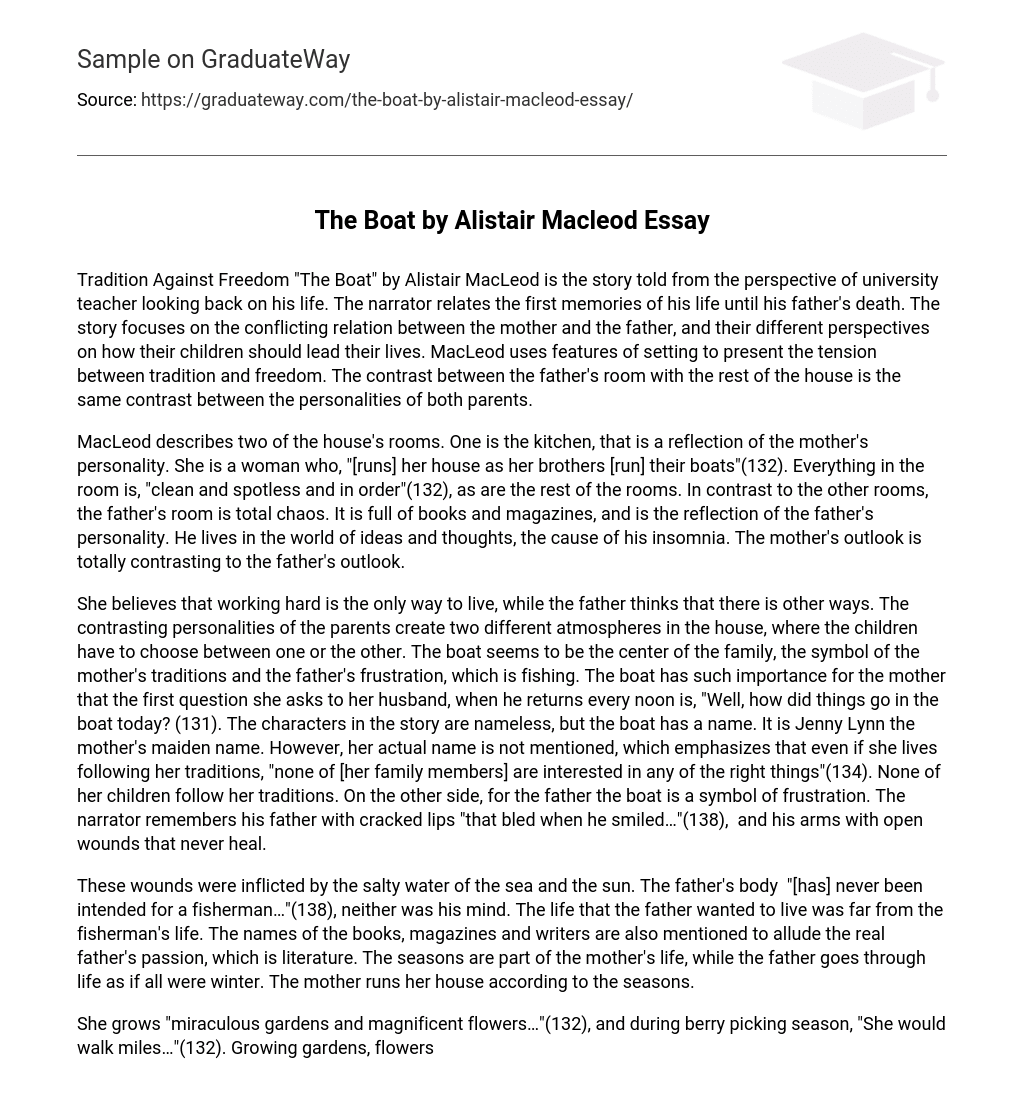Tradition Against Freedom “The Boat” by Alistair MacLeod is the story told from the perspective of university teacher looking back on his life. The narrator relates the first memories of his life until his father’s death. The story focuses on the conflicting relation between the mother and the father, and their different perspectives on how their children should lead their lives. MacLeod uses features of setting to present the tension between tradition and freedom. The contrast between the father’s room with the rest of the house is the same contrast between the personalities of both parents.
MacLeod describes two of the house’s rooms. One is the kitchen, that is a reflection of the mother’s personality. She is a woman who, “[runs] her house as her brothers [run] their boats”(132). Everything in the room is, “clean and spotless and in order”(132), as are the rest of the rooms. In contrast to the other rooms, the father’s room is total chaos. It is full of books and magazines, and is the reflection of the father’s personality. He lives in the world of ideas and thoughts, the cause of his insomnia. The mother’s outlook is totally contrasting to the father’s outlook.
She believes that working hard is the only way to live, while the father thinks that there is other ways. The contrasting personalities of the parents create two different atmospheres in the house, where the children have to choose between one or the other. The boat seems to be the center of the family, the symbol of the mother’s traditions and the father’s frustration, which is fishing. The boat has such importance for the mother that the first question she asks to her husband, when he returns every noon is, “Well, how did things go in the boat today? (131). The characters in the story are nameless, but the boat has a name. It is Jenny Lynn the mother’s maiden name. However, her actual name is not mentioned, which emphasizes that even if she lives following her traditions, “none of [her family members] are interested in any of the right things”(134). None of her children follow her traditions. On the other side, for the father the boat is a symbol of frustration. The narrator remembers his father with cracked lips “that bled when he smiled…”(138), and his arms with open wounds that never heal.
These wounds were inflicted by the salty water of the sea and the sun. The father’s body “[has] never been intended for a fisherman…”(138), neither was his mind. The life that the father wanted to live was far from the fisherman’s life. The names of the books, magazines and writers are also mentioned to allude the real father’s passion, which is literature. The seasons are part of the mother’s life, while the father goes through life as if all were winter. The mother runs her house according to the seasons.
She grows “miraculous gardens and magnificent flowers…”(132), and during berry picking season, “She would walk miles…”(132). Growing gardens, flowers and picking berries are seasonal activities. Every flower and fruit has its cycle during the year, which alludes how the mother lived through this. The importance of the seasons as part of the mother’s life is presented even in the end of the story when the narrator says that the “[mother] looks through her lonely window onto the ice of winter…”(140).
Therefore, she is alone gazing out the window, waiting for her death, which is symbolized by the winter. On the other hand, for the father all the seasons are the same. All of them are winter. The narrator describes his father, “with blue eyes flossing like clearest ice beneath the snow…”(134). The physical aspect of the father alludes to winter. He also wears wool sleeves all year long, when the rest of the fishermen wear them just in the winter. He goes into depression during the winter and this depression extends until the beginning of the spring.
The father decides to get up out of his bed, when his son decides to drop out of school. The father’s desire for his children to be free and follow their own dreams is so longed for that his depression comes to second plane. In the end, the narrator not just lives following his dreams, but also tormented by his father’s suicide. The father decided to jump out of the boat in the middle of a storm in order to free his son from the same life he lived. On the other hand, the mother’s stubbornness leads her to a lonely life and contributes to her son’s torment.
The contrast between the parents are presented during the whole story. The mother is order, while the father is chaos. The mother represents tradition, and the father represents freedom. These two different personalities create the conflicting atmosphere that falls over the family, concluding that freedom does not always lead to happiness. Work Cited MacLeod, Alistair. “The Boat. ” Literature and the Writing Process. Elizabeth McMahan et al. 1st Canadian ed. Toronto: Pearson, 2005. 130-141.





